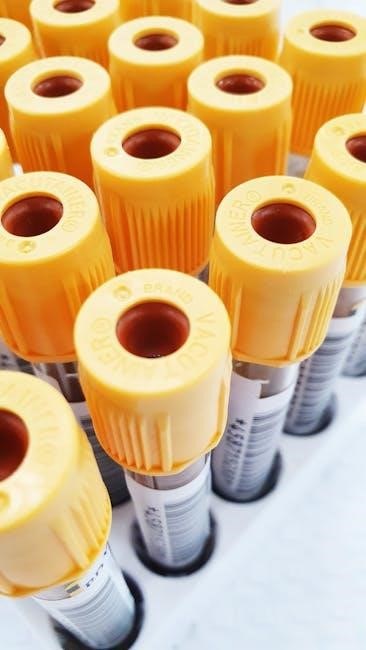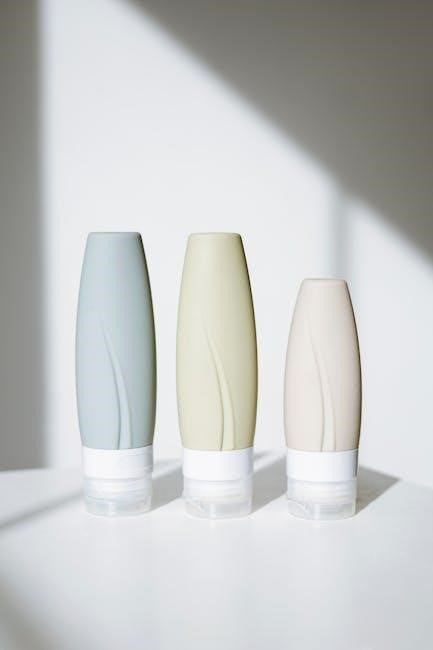The BD Vacutainer System is a standardized method for blood collection, ensuring safety, accuracy, and efficiency in specimen collection. It minimizes contamination risks and promotes consistency in laboratory testing, adhering to clinical guidelines and regulatory standards. The system includes specialized tubes and safety features designed to enhance patient care and streamline workflows in healthcare settings globally.

1.1 Overview of BD Vacutainer Tubes
BD Vacutainer Tubes are a comprehensive range of blood collection devices designed for various diagnostic purposes. They include serum separator tubes (SST), EDTA tubes for hematology, and specialized tubes for unique testing needs. Each tube is formulated with additives or coatings to ensure accurate laboratory results. The tubes are part of a closed system, reducing contamination risks and enhancing safety for healthcare professionals. They support efficient blood collection, proper sample preparation, and reliable test outcomes, making them a cornerstone in modern phlebotomy practices worldwide.
1.2 Importance of Proper Blood Collection Techniques
Proper blood collection techniques are crucial for ensuring accurate laboratory results and minimizing risks. Incorrect methods can lead to contamination, hemolysis, or inaccurate test outcomes, potentially delaying diagnosis. The BD Vacutainer System emphasizes the use of a closed system to reduce exposure to bloodborne pathogens and improve safety. Adhering to recommended protocols ensures high-quality specimens, supports patient care, and maintains regulatory compliance. Proper techniques also enhance safety for healthcare workers by minimizing needlestick injuries and promoting efficient workflows in clinical settings.
BD Vacutainer Tube Guide: Order of Draw
The BD Vacutainer Tube Guide: Order of Draw provides a standardized protocol for blood collection, ensuring accurate test results and specimen integrity by preventing cross-contamination of additives. Adhering to this sequence is critical for reliable laboratory outcomes.
2.1 Recommended Sequence for Blood Collection
The recommended sequence for blood collection using BD Vacutainer Tubes begins with sterile or coagulation tubes, followed by serum separator tubes (SST), EDTA tubes, and specialized tubes. This order prevents additives from interfering with test results. Immediate mixing is essential, especially for EDTA tubes, to ensure accurate hematology testing. Proper centrifugation techniques and adherence to the Clinical and Laboratory Standards Institute (CLSI) guidelines are crucial for maintaining sample integrity and avoiding re-draws. This standardized approach ensures reliable laboratory outcomes and supports patient care.
2.2 Clinical and Laboratory Standards Institute (CLSI) Guidelines
The Clinical and Laboratory Standards Institute (CLSI) provides standardized guidelines for blood collection to ensure accuracy and reliability in laboratory testing. These guidelines emphasize the importance of proper tube selection, order of draw, and mixing techniques. Adherence to CLSI recommendations minimizes pre-analytical errors and ensures consistency across healthcare settings; The BD Vacutainer System aligns with these guidelines, offering a structured approach to blood collection that supports compliance and delivers high-quality specimens for diagnostic testing. Following CLSI standards is essential for maintaining patient care and laboratory integrity.

Types of BD Vacutainer Tubes

BD Vacutainer tubes are designed for various diagnostic needs, including serum separation, hematology, and specialized testing. Each tube type supports accurate and reliable blood specimen collection.
3.1 Serum Separator Tubes (SST)
Serum Separator Tubes (SST) are designed to collect blood samples for serum separation. They contain a gel barrier that, when centrifuged, separates serum from blood cells. This ensures accurate test results by preventing cellular interference. SST tubes are essential for various clinical tests, including chemistry profiles and serology. Proper centrifugation is critical to maintain specimen integrity and reliability in laboratory diagnostics, making SST a cornerstone in modern blood collection practices.
3.2 EDTA Tubes for Hematology Testing
EDTA (Ethylene Diamine Tetraacetic Acid) tubes are essential for hematology testing, as they prevent blood clotting by chelating calcium ions. They are used for complete blood counts (CBC) and other tests requiring whole blood analysis. Immediate mixing after collection is critical to ensure accurate results. EDTA tubes are available in various sizes and are designed to maintain blood cell integrity during testing. Proper handling and adherence to collection guidelines are vital for reliable hematology diagnostics, making EDTA tubes indispensable in clinical and laboratory settings for assessing blood cell health and disorders.
3.4 Specialized Tubes for Diagnostic Testing
Specialized BD Vacutainer tubes are designed for unique diagnostic requirements, offering tailored solutions for specific tests. These tubes often contain specialized additives or coatings to preserve samples for accurate analysis. For example, coagulation tubes use sodium citrate to prevent clotting, while glucose tubes contain glycolytic inhibitors. Certain tubes are sterile for microbiology testing or contain enzymes for molecular diagnostics. These specialized tubes ensure precise test outcomes, enhancing diagnostic accuracy and streamlining laboratory workflows. Proper selection and handling are crucial for reliable results in advanced diagnostic testing scenarios.
Handling and Mixing Guidelines
Proper handling and mixing of BD Vacutainer tubes are crucial for accurate test results. Immediate mixing after collection prevents clotting and ensures sample integrity. Inadequate mixing may require re-draws.
4.1 Immediate Mixing Requirements
Immediate mixing of BD Vacutainer tubes is essential to ensure specimen integrity. Tubes containing additives like EDTA or clot activators require gentle inversion 5-10 times. This prevents clot formation and ensures accurate test results. Delayed mixing can lead to inaccurate lab outcomes, potentially requiring repeat blood draws. Proper mixing is critical for maintaining sample viability and adherence to clinical standards, ensuring reliable diagnostic results for patient care.
4.2 Proper Centrifugation Techniques
Proper centrifugation of BD Vacutainer tubes is critical for accurate test results. Tubes should be centrifuged at 1100-1300 RCF for 10 minutes to ensure complete separation of blood components. Gel tubes must not be centrifuged in refrigerated units to prevent clotting. Proper techniques prevent hemolysis and maintain sample integrity, ensuring reliable laboratory outcomes. Adherence to these guidelines minimizes errors and supports accurate diagnostic testing, which is essential for patient care and clinical decision-making.
Safety Features of BD Vacutainer Tubes
The BD Vacutainer System incorporates needle safety mechanisms and a closed blood collection system, reducing the risk of needlestick injuries and contamination during specimen collection.
5.1 Needle Safety Mechanisms
BD Vacutainer tubes feature advanced needle safety mechanisms, including passive safety devices that automatically shield the needle after blood collection, minimizing the risk of needlestick injuries. These mechanisms are designed to protect healthcare workers from accidental exposure to bloodborne pathogens. The Safety-Lok system ensures the needle is securely locked in place, preventing reuse or accidental contact. This innovation aligns with FDA and clinical standards, promoting a safer environment for specimen collection and handling.
5.2 Closed System for Blood Collection

The BD Vacutainer System utilizes a closed system for blood collection, preventing exposure to bloodborne pathogens and reducing contamination risks. This sterile, closed environment ensures specimen integrity and safety throughout the collection process. The system’s design minimizes the need for multiple needle sticks, enhancing patient comfort and safety. By maintaining a closed system, it adheres to FDA and CLSI guidelines, providing reliable and accurate test results while protecting healthcare workers from potential biohazards.

Clinical and Laboratory Compliance

The BD Vacutainer System ensures compliance with FDA and CLSI guidelines, promoting accurate test results and maintaining specimen integrity in clinical and laboratory settings.
6.1 Adherence to Regulatory Standards
BD Vacutainer tubes are designed to meet stringent regulatory standards, ensuring compliance with FDA and CLSI guidelines. Adherence to these standards guarantees accurate and reliable test results, minimizing errors and ensuring patient safety. Proper use of these tubes aligns with clinical protocols, maintaining specimen integrity and supporting diagnostic accuracy. Compliance with regulatory standards is crucial for healthcare providers to deliver high-quality care and trust in laboratory outcomes. This ensures that all blood collection processes are standardized and meet global healthcare expectations.
6.2 FDA and CLSI Compliance
BD Vacutainer blood collection tubes are fully FDA 510(k) cleared and comply with CLSI guidelines, ensuring adherence to rigorous safety and performance standards. This compliance guarantees that the tubes meet regulatory requirements for accurate and reliable blood collection. FDA clearance verifies the safety and effectiveness of the tubes, while CLSI standards ensure consistency in blood specimen collection. Together, these certifications uphold the quality and integrity of blood samples, supporting accurate laboratory testing and patient care.

Best Practices for Blood Collection
Proper venipuncture techniques, patient preparation, and adherence to safety protocols are essential for accurate and reliable blood collection. Ensuring sample integrity is critical for valid test results.
7.1 Patient Preparation and Venipuncture Techniques
Proper patient preparation involves ensuring fasting or hydration as required by the test. Venipuncture techniques should follow sterile procedures to minimize contamination. Use of BD Vacutainer tubes with Safety-Lok needles reduces needlestick injuries. Ensuring correct tube selection and order of draw is vital for accurate results. Gentle mixing of tubes post-collection prevents clotting and ensures sample integrity. Adherence to these practices enhances patient safety and specimen quality, leading to reliable laboratory outcomes. Proper training and adherence to guidelines are essential for optimal blood collection processes.

7;2 Ensuring Sample Integrity
Ensuring sample integrity involves proper handling and processing of BD Vacutainer tubes post-collection. Immediate mixing of blood with additives prevents clotting and ensures accurate test results. Centrifugation must follow recommended protocols, with gel tubes avoiding refrigerated centrifuges. Proper storage conditions and handling procedures are critical to maintaining specimen quality. Adherence to these steps minimizes pre-analytical errors, ensuring reliable laboratory outcomes and accurate patient care.